Mother of Thousands (or Millions) Plant Care – How to Grow Kalanchoe
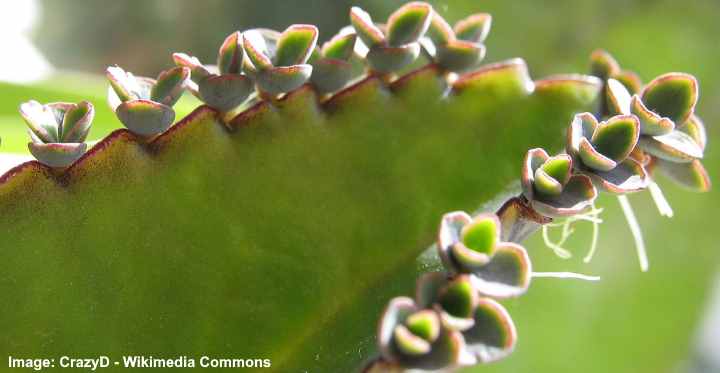
The mother of thousands plant (Bryophyllum daigremontianum or Kalanchoe daigremontiana) is an interestingly-shaped plant that thrives indoors as a houseplant. The mother of thousands succulent plant has other common names such as alligator plant, devil’s backbone, Mexican hat plant, or mother of millions. These common names can give you an idea as to its appearance. The unusual feature of the mother of thousands is the tiny plantlets that grow along the leaf margins. These plantlets grow roots, making the plant easy to propagate.
How to care for the mother of thousands: the plant thrives when growing in well-draining potting soil, kept in bright filtered sunlight, and watered occasionally. Being a type of succulent, this plant doesn’t need high humidity and needs average room temperature of 65°F to 75°F (18°C – 23°C). Fertilize occasionally and remove the plantlets to prevent them from growing wherever they land.

Potted mother of thousands plant. Plants can grow up to 1.85 m tall (6 feet)
The mother of thousands is a highly invasive plant. The tiny plantlets grow vigorously, and the succulent can quickly overtake a garden. So, if you are growing the plant outdoors, it’s best to grow it in a container. These plants are extremely fast growers, so you should take that into account.
You may find that the mother of thousands has two different botanical names–Bryophyllum daigremontianum and Kalanchoe daigremontiana. It has those Latin names because the succulent plant is classified in the genera Kalanchoe and Bryophyllum.
In this article, you will find out how to care for the mother of thousands plant. At the end of the article, you will find answers to many common questions about growing the plant.
How the Mother of Thousands Grows
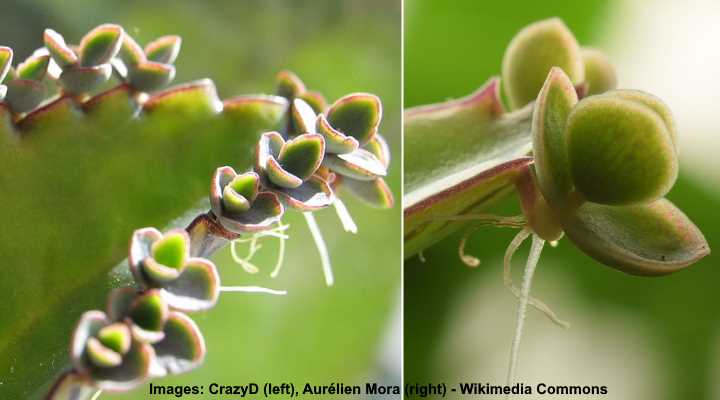
Mother of thousands plantlets
This succulent plant grows from a single stem that has thick, fleshy oblong leaves called phylloclades that are lanceolate-shaped. The large “leaves” grow up to 6” (15 cm) long and 3” (7.5 cm) wide. The plant isn’t called a “mother” for no reason. All mothers have babies, and this Kalanchoe species also produces “babies” called plantlets.
Mother of thousands also reproduces very rapidly—hence the other name “mother of millions.” These tiny “offspring” are fascinating to look at. If you look closely at pictures of mother of thousands plants, you may even see small roots growing from the plantlets.
These plants are also a flowering type of succulent. However, they rarely—if ever—bloom indoors. If you have these plants in a sunny spot in your garden, you may get flowers in late winter.
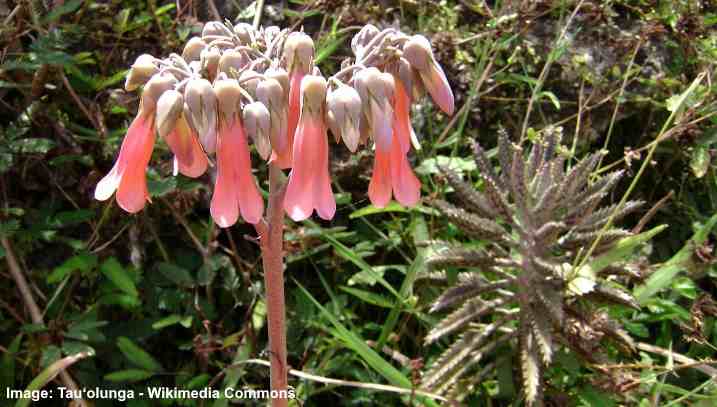
Mother of thousands flower
How to Take Care of Mother of Thousands Plant (Alligator Plant)
Although succulents such as mother of thousands are reasonably easy to look after, there are a few things to know about their care. Read on to find out how to care for this interesting plant indoors.
Mother of Thousands Light Requirements
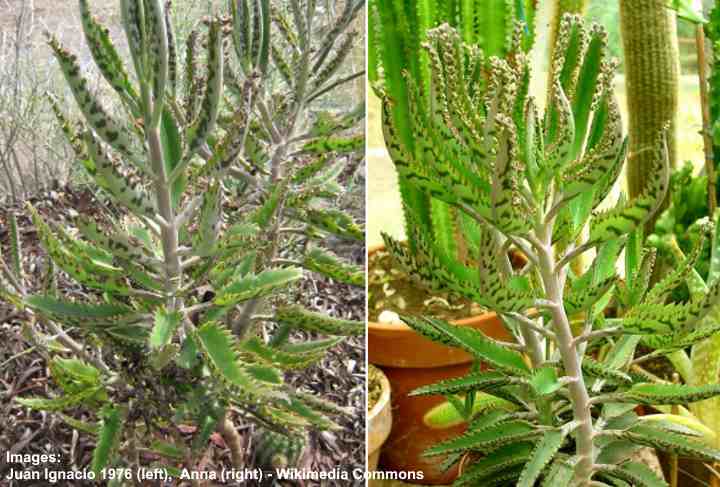
The leaves of mother of thousands plant are green above and have purple blotches underneath. The Alligator plant needs several hours of bright sunlight to thrive
The mother of thousands plants need several hours of bright sunlight to thrive. The best location for a kalanchoe is on an east- or west-facing window where it gets plenty of light. During summer, put the succulent in a place where it gets indirect sunlight to protect the leaves from burning.
Due to their need for sunlight, mother of thousands isn’t suitable to grow as a low-light plant. So, avoid placing them in rooms that face north, windowless bathrooms, or other shaded locations.
To tell if a mother of thousands is getting enough light, look at the leaf coloring. The leaves should be vibrant green with a hint of redness along the edges. If your devil’s backbone plant is lacking sunlight, it will start growing leggy. Leaves will sparsely grow on the stem making the succulent tall and spindly.
The Best Soil to Grow Mother of Thousands
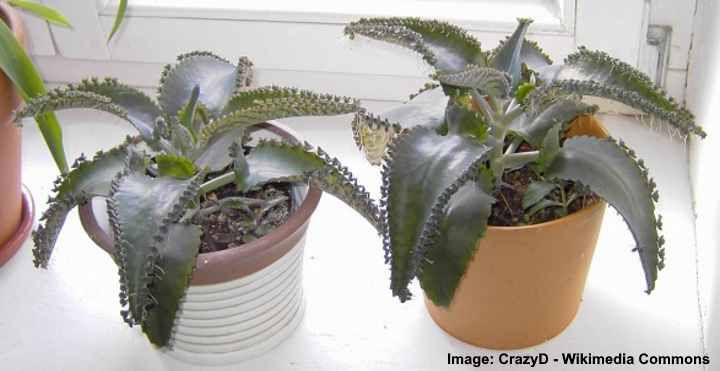
The best soil for the alligator plant is sandy soil or cactus mix
Mother of thousands needs to grow in a potting mix that provides good drainage. Sandy soil is the best type of potting medium for these succulents. Cactus mix also works well for mother of thousands if you want to care for them properly. You can make suitable soil for the plants by mixing regular potting soil with perlite.
The most crucial care requirement for mother of thousands is to avoid soggy soil. So, whether you use potting soil with sand, perlite, vermiculite, or pumice, water needs to drain quickly. It’s best to avoid loamy soil or potting mix that has peat moss or humus in it.
To help increase drainage, you could put a layer of pebbles on the bottom of the pot. This layer of small stones not only improves water drainage but helps air circulate in the soil.
Of course, controlling soil moisture depends on more than just the right soil. You need to water a mother of thousands properly and grow it in the right pot. These are the following ways to look after your succulents.
How to Water a Mother of Thousands
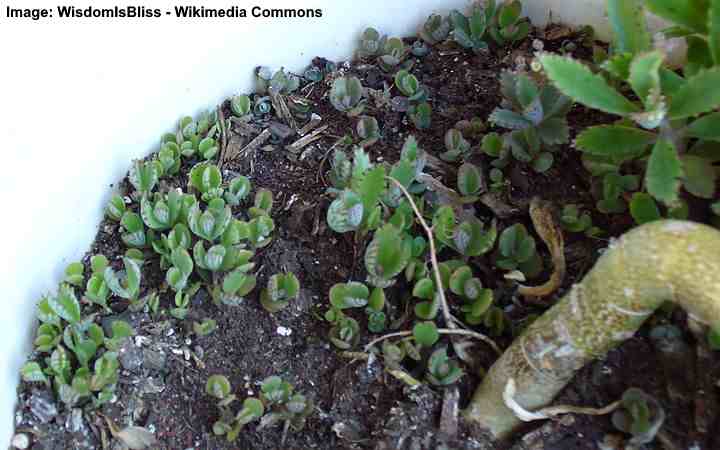
The plantlets of mother of thousands plant grow wherever they land
For mother of thousands to thrive indoors, you should only water it when the soil is partly dry. Check that the top 2” (5 cm) of the potting mix has completely dried out before watering thoroughly. Pour in enough water until it starts draining from the bottom. This type of watering ensures that the roots get the essential moisture they need.
There are three mistakes to avoid when watering mother of thousands. To avoid these mistakes, this is the best advice to follow:
- Don’t water alligator plants on a regular schedule—This often results in over-watering where the soil becomes too damp and soggy. Waterlogged soil causes succulents to develop root rot, and they may eventually die. Only water when the soil has dried out partially.
- Avoid frequent shallow watering—Watering this way doesn’t allow the roots to get any moisture. All that happens is that the soil near the top stays damp, which creates the right environment for fungus gnats to thrive.
- Don’t water the leaves—Always water the soil, not the leaves. Water on the leaves can cause rot if they get too wet.
When watering a mother of thousands, try to use water at room temperature. All you need to do is keep a jar of water out overnight. Leaving water in an open container also has the added benefit of allowing harmful chemicals in tap water to evaporate. Thorough watering with water at room temperature avoids stressing the sensitive kalanchoe roots.
The Right Pot for Mother of Thousands
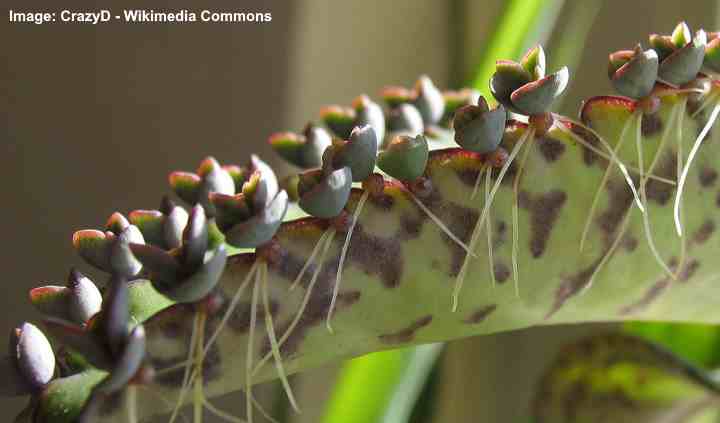
The best type of pot to grow mother of thousands is a terracotta pot with a drainage hole in the bottom. The hole allows excess water to drain out, and the terracotta pot enables the soil to “breathe.” Also, a clay container doesn’t hold as much moisture as plastic or ceramic containers. A combination of the right pot, appropriate watering, and well-draining soil will all help your mother of millions to thrive.
Always make sure that water doesn’t collect in the saucer under the pot. This usually results in moisture seeping back into the soil, making it soggy. The results of saturated soil are root rot, fungal soil problems, and dying kalanchoes.
Mother of Thousands Care: The Right Temperature
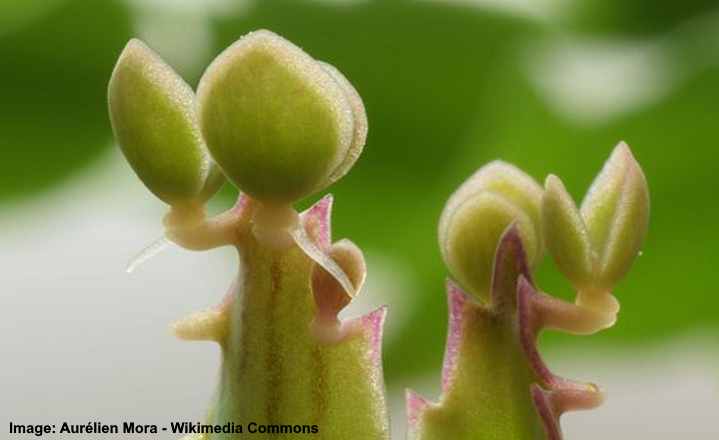
Plantlets at the end of the fleshy succulent leaves – the best temperature range for the alligator plant is between 65°F and 75°F (16°C – 24°C)
Mother of thousands is an excellent houseplant because it thrives in average room temperatures. The best temperature range for Mexican hat plants is between 65°F and 75°F (16°C – 24°C). The vital care factor when it comes to temperature is to keep them away from extremes.
In winter, when the household heating is on, keep mother of thousands away from radiators or other sources of heat. In summer, make sure that the kalanchoe pot doesn’t stand in drafts or air conditioning airflow. Because excessive heat can burn the leaves, don’t have a mother of thousands on a south-facing windowsill unless it is shielded from direct sunlight.
The Best Humidity to Care for Mother of Thousands
Mother of thousands isn’t fussy when it comes to humidity. Being a type of succulent, these plants prefer drier conditions because they store moisture in their leaves. So, you don’t need to mist the leaves or use a room humidifier.
Fertilizer for Healthy Mother of Thousands Growth
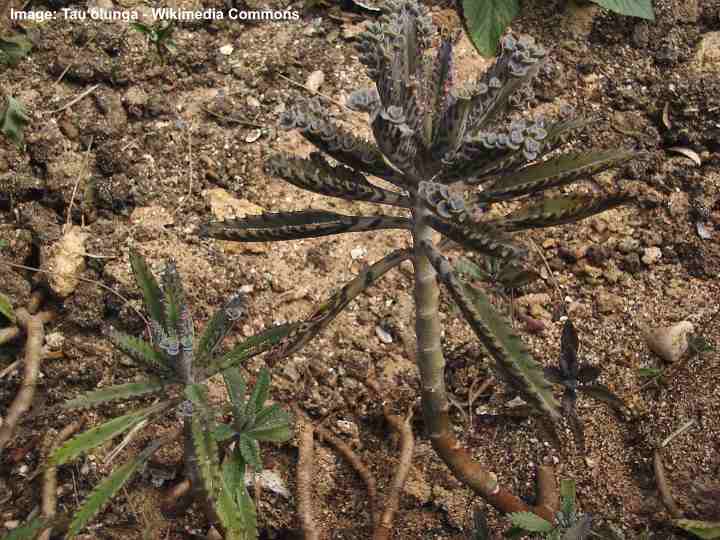
Bryophyllum daigremontianum doesn’t need frequent fertilization to grow well. There usually enough nutrients in the soil for healthy growth. However, you can fertilize these plants with a balanced, diluted liquid houseplant fertilizer. Fertilize every three months in the growing season—from March to September.
Pruning Mother of Thousands Plant
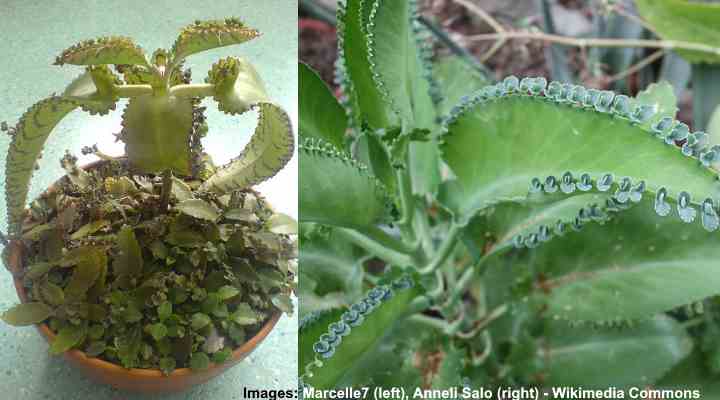
Mother of thousands benefits from pruning every so often. Like with many indoor plants, pruning Bryophyllum daigremontianum can help to encourage new, denser growth. Pruning is also a way to remove tall spindly stems from the succulent to improve its appearance.
The best way to prune a mother of thousands is to trim off the top part of the plant just above a leaf. Because mother of thousands is a fast-growing succulent, new growth should appear fairly quickly. With regular pruning, you can encourage thick, healthy growth.
Always remember to clean away any plantlets that have fallen as they will root quickly. Because mother of thousands is very invasive, also make sure that the “babies” don’t fall into the soil in your yard.
Repotting Mother of Thousands

Mother of millions flower
You should transfer the mother of thousands to a larger pot when it becomes rootbound. Giving the roots more room helps the succulents to grow better and prevents stunted growth. There are several ways to tell when it’s time to repot your kalanchoe. Repot mother of thousands when you notice any of these signs:
- Roots start to poke out from the drainage holes.
- Water drains poorly because the roots are too dense.
- The plant’s growth slows because the roots can’t get enough nourishment.
- Soil dries out faster, even in colder temperatures.
When choosing a new pot for your plant, pick a terracotta pot that has drainage holes. It should be 1” to 2” (2.5 – 5 cm) larger than the previous one. Here are the steps to repot a mother of thousands:
- Carefully remove the mother of thousands from the pot.
- Gently shake the roots to remove excess soil. You could also put the root ball under a running faucet to get all the dirt off.
- Check the roots for any signs of disease—mushy brown roots.
- In a new pot, put a layer of pebbles on the bottom of the container.
- Fill one-third of the pot with cactus potting mix or sandy soil.
- Place the plant in the pot, making sure it’s growing at the same height as previously.
- Fill the remaining space with potting mix and gently press around the stem to give some support.
- Thoroughly water and place the mother of thousands in a bright location to continue thriving.
The best time to repot the plants is in the spring. This time is just at the start of the growing season. Also, the warmth and sunlight will help your delicate plants cope with the stress of replanting.
Grow New Mother of Thousands—Propagation
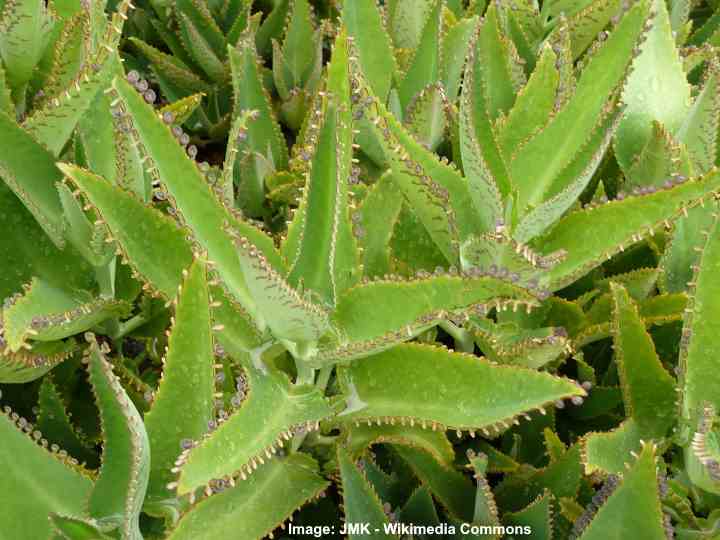
Mother of millions is one of the easiest houseplants to propagate. Outdoors, these kalanchoes are so invasive that they quickly reproduce and take over a garden. Propagation is done by the tiny “babies” or plantlets growing along the devil’s backbone.
To propagate mother of thousands, you’ll need a terracotta pot filled with a light potting mix. This is what you should do:
- Pick off some of the plantlets and place them in the container about 0.5” (1 cm) apart.
- Spray the plantlets and the soil with water, but don’t over-water them.
- Cover the container with some plastic film to lock in moisture and heat.
- Place the pot in a bright location.
- Spray with a fine mist every so often to make sure the soil is only slightly moist.
- When they grow to about 1” (2.5 cm) tall, you can repot the individual plants in a new container.
FAQ About Mother of Thousands
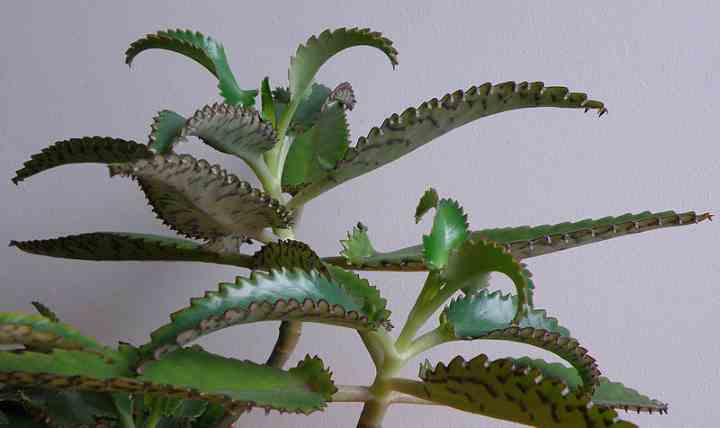
Although mother of thousands plants are easy to grow houseplants, there are a few questions you may still have about growing them.
Does mother of thousands flower?
Mother of millions is a type of flowering succulent. However, the plants rarely—probably, never—bloom indoors. When growing outdoors, your plant may bloom with clusters of small pinkish-red flowers. Always deadhead the flowers after blooming to encourage good growth.
Is mother of thousands plant poisonous?
Yes. All parts of Kalanchoe daigremontiana contain toxic substances called bufadienolides. The American Society for the Prevention of Cruelty to Animals (ASPCA) lists the devil’s backbone on their list of poisonous plants that are toxic to dogs and cats. (1)
Is the mother of thousands invasive?
Mother of thousands is an extremely invasive and fast-growing plant. If you grow this succulent outdoors in your yard, regularly collect the plantlets to prevent them from rooting where they land.
Why are mother of thousands leaves curling?
Mother of thousands has broad leaves in the shape of a tear or diamond. The leaves have a natural arch, but they shouldn’t curl. Curling Mexican hat plant leaves are usually a sign of over-watering or getting burned by too much sun.
Why is my mother of thousands dying?
There can be several reasons why a mother of thousands starts to wilt and eventually dies. The most common reasons why an alligator plant looks like it’s dying include over-watering, too much direct hot sunlight, or under-watering. If you act in time, you may be able to save a dying plant.
Is a mother of thousands a good plant for terrariums?
Mother of thousands is not the right plant for closed terrariums because they are invasive and can affect other plants. These plants produce chemicals that can stunt the growth of other nearby plants. Also, these succulents may not grow as well in the moist, tropical environment of terrariums.
Related articles:
